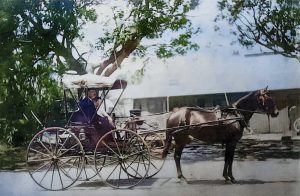Its single-story structure, built beside a large store, was described as commodious, a welcome refuge for travellers and a social centre for locals. However, the hotel’s lively history would come to a dramatic end in 1922, when a fire ravaged both the hotel and the adjoining stores, marking the end of an era in Walgett. The hotel’s licence was later surrendered, officially closing a chapter that had spanned over four decades.
John Staunton, the first licensee of the Commercial Hotel, was a prominent figure in Walgett. Born in 1843 in Broulee, New South Wales, Staunton had settled into his role as a community leader by the time he took over the Commercial Hotel in 1881. A popular businessman and dedicated family man, he and his wife, Bridget Gilchrist, raised 10 children, and his deep community involvement spanned decades, punctuated by remarkable episodes that earned him admiration and respect. He held the license on and off until 1907, with E. Everingham and others taking the reins briefly between his terms. Staunton’s legacy was indelibly marked by his character, which made him an essential figure in the social life of Walgett. Staunton’s reputation was built not only on his business but also on his courage and resilience.
In 1886, his 10-year-old son heroically rescued two children from drowning in the Namoi River. Later, in 1890, when a devastating flood submerged much of Walgett, the Commercial Hotel was closed along with other establishments. Yet, Staunton’s two-story residence at the edge of town became a refuge for stranded townspeople, who were brought to safety by police.
Despite his positive impact, Staunton faced his share of controversies. In 1891, he was taken to court for assault and fined £6 for a dispute with Mr. Howard of the Wolseley sheep-shearing machine company. He also had a notable clash with Judge Docker in 1898 during a slander case, leading him to request that his name be removed from jury duty as long as Docker presided over the district. Legal wrangling continued in 1894, when he successfully defended himself against John Duhigg, who claimed Staunton had breached a contract to sell him the hotel.
Staunton’s life was full of stories that became part of the town’s lore. One humorous tale, recounted in 1892, involved Staunton’s loyal kangaroo dog. On a long ride in the bush, the dog was left behind, resting under a tree, while Staunton continued his journey. Upon returning home, he realised he’d lost a silk handkerchief. The next day, the dog returned to him—handkerchief in mouth—delighting Staunton and his friends, who marvelled at the dog’s loyalty and intelligence.
Another incident in 1888 saw Staunton mistakenly confirm via telegram that a “Mr. Jackson” (a passenger by coach) was staying at his hotel, only to realise the message referred to a racehorse of the same name in his stables. The misunderstanding brought laughs and became a tale recounted with affection.
After Staunton’s final departure from the Commercial Hotel in 1907, a string of licensees took over. Thomas Murray, Michael Murray, and Michael Thomas Gleeson each left their mark. Gleeson, who bought the hotel in 1910, became a respected civic leader, serving as President of the Walgett Shire. In 1912, he moved to Bourke, taking over the Gladstone Hotel but still holding ownership of the Commercial. Gleeson’s influence extended to the end of the hotel’s existence, when it burned down in 1922, he opted to surrender its license to the NSW Licenses Reduction Board. Along with Richard Judge, who managed the hotel from 1918 to 1922, Gleeson received compensation for the loss, finalising the hotel’s closure.
Thus, the Commercial Hotel’s story, filled with tales of heroism, humour, and resilience, stands as a testament to Walgett’s lively past. From Staunton’s leadership and adventures to the final act of the fire that sealed its fate, the hotel reflected the spirit of a community that, like Staunton himself, would overcome obstacles and create enduring memories.
Information kindly provided by Bruce Gray

Pubs and Breweries of Walgett
While there is no substantive hotel currently operating in Walgett, the village on the junction of the Namoi and Barwon Rivers is a major hub of pastoralism and cropping, as well as a place of great significance for Aboriginal people. During its history, there were at least eight separate hotels in Walgett at different times – and a brewery.


